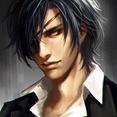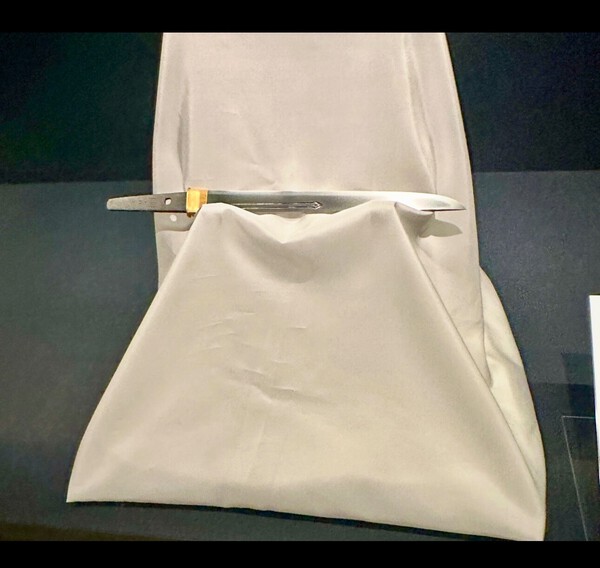-
Posts
1,917 -
Joined
-
Last visited
-
Days Won
22
Content Type
Profiles
Forums
Events
Store
Downloads
Gallery
Everything posted by Gakusee
-
There were several threads a few months ago about faking Juyo swords. Chris / Hoshi commented on them and a few others. Someone in Japan has been “re-creating” Juyo rated swords off the oshigata in the Juyo books. Probably stolen or misplaced Juyo origami which the person on Yahoo somehow got hold of. The authentic Japanese swords were properly forged and imitated the hamon but there were differences to what one would expect of the original. These were supposed to be high level swords (Go, Awataguchi etc) with genuine Juyo and TokuJu origami but the nie was not right or the specific hataraki, though very close, were not an identical match to the oshigata or TJ photo or the nakago was ever so slightly off. Worthwhile checking these threads…
-
You are looking at a grossly enlarged image and over exaggerated kizu. In real life these will be barely visible due to their tiny size. However, the positive features, ie the vivid and rich utsuri combined with the rich hamon activities will always be there and visible. Speaking from my own experience, I have noticed that we as collectors have started obsessing over the slightest defect in these usually highly enlarged images, which, however, with the sword in hand, are either not noticeable or barely visible. To compensate for that, I have started scaling down the image, still on a high resolution large screen, to real size (usually measured at yokote and/or machi) in order to get a sense of the real scale of the kizu. I think it is clear that 3 and 5 are good quality Nambokucho Aoe.
-
Don’t get discouraged - people cannot tell much in some cases. I think most of those who commented conjecture that 3 is probably the best. Number 2 has interesting hataraki and utsuri but the jigane is tired….And of Nanbokucho Aoe one expects high quality and refined jigane.
-
On the basis of these photos, I would not buy any of these. To me, an exciting hamon, full of hataraki, even if they are delicate and small ko-ashi, is a prerequisite. Not only does that signify greater skill and steel but also I find it aesthetically more pleasing. Here I cannot discern that on the basis of these photos and all I can adjudge is the sugata. Frankly, probably because my expectations are high, as a Bizen collector I still have not bought an Aoe blades after all these years….
-
Ray,you cannot expect a thorough view based only on sugata, unless you only ask about shape….. With Aoe, one needs to look at: 1) Jigane: is it fine? 2) Utsuri: is it dan utsuri (common for the Nanbokucho Aoe you are sharing) 3) Hamon: are there delicate saka ashi so typical and desirable of Aoe? Etc. Unless you attach the side, angled photos showing these characteristics, one cannot formulate a proper view as the hadori obfuscates the hamon and one cannot opine on the utsuri etc
-

Advice for new collectors from an old dog
Gakusee replied to R_P's topic in General Nihonto Related Discussion
Alex FYI. However, I do not wish to digress in Rayhan’s advice thread, so let us please adhere to sharing advice / tips etc. He means well at the bottom of his heart. -

Advice for new collectors from an old dog
Gakusee replied to R_P's topic in General Nihonto Related Discussion
Ray One or two comments from people from a certain country cannot equate to the entire country or be a representative sample. Indeed, you have contributed a lot to the study of swords in the U.K. and even here (eg, sharing all the scanned magazines and books!) and internationally (eg study sessions in Japan). You have trodden the tortuous path of collecting numerous swords from various sources (eg people could refer to your publication of your previous collection) and experienced first-hand numerous dealers and people in the community. You are trying to share some of your painful experiences so that others do not get burnt the way you did previously. Our To-Ken Society (which numbers 220 members by the way, not the 2-3 which are more vocal here) is grateful for what you have shared in terms of study material. The desire and ambition to educate is noble and yet the approach needs to be proportionate and appropriate. What might be pertinent for a certain member might not be suitable for another. We are all grown up here and can decide to heed advice or not. Unfortunately such is life - whether in politics, religion, business, hobbies etc. People sometimes listen/learn and sometimes choose to ignore what they are told. We as humans are all flawed like that. There are numerous valid tips you share above. In fact, I would say the advice you give is concordant with the straightforward “canon” in Japan. But emotion as well personal circumstances (and most importantly probably the lack of funds) might prevent people from following that archetype. The economic factor as well as impatience (covered elsewhere) often prevail. Please let us adhere to educating (or trying to). There are various lecturers and teachers here on this board (I know a few and they are prominent members of the board and the nihonto / armour / dealer community) and they can also attest: you can teach, explain etc but it is up to the individual student to wish to learn, follow recommendations etc.- 142 replies
-
- 14
-

-

-
This could well be Naoe Shizu, some exceptional Tametsugu, rough Sa school
-

Why is saving for a sword a taboo ?
Gakusee replied to R_P's topic in General Nihonto Related Discussion
@Rayhan @Bugyotsuji Given that you two, esteemed gentlemen, are both in London currently, whilst residing elsewhere permanently, I think you should grab a coffee or cocktail. Knowing both of you, I am positive you will get along nicely and can discuss your disparate collecting interests, spanning much more than nihonto…. -
But this blade (1310) posted by Chris above is the only one in the Kozan with a relevant date in the relevant era. The others either do not have nengo or are dated 1318 and 1328. The important point, again flagged by Chris, for people to realise is that indeed the tangs in the Kozan are drawings and artistic interpretations of the mei, but are not truthful oshigata. So the Kozan is a source which summarises actual existing blades and dates etc but one cannot look at the Mei and try to compare it for veracity and accuracy to their own. I do trust that source and would not go about saying it is full of gimei etc. Quite the opposite in fact as it tends to have famous and ex-daimyo blades, so with higher chance of authenticity.
-

Why is saving for a sword a taboo ?
Gakusee replied to R_P's topic in General Nihonto Related Discussion
Hope that you feel better soon and that it is nothing too serious. And as to this thread, the opinions have been stridently stated, arguments passionately made pro and con, and it is clear that one approach whilst well-intended might not fit everyone. Digging one’s heels in is usually counterproductive and I echo we ought to respect each other’s views and positions. -

Why is saving for a sword a taboo ?
Gakusee replied to R_P's topic in General Nihonto Related Discussion
So gents, let us indeed adhere to a neutral and civil tone of exchange. Ray, when we were starting out 20-30 years ago, there was less info available, fewer purchase / learning choices in the Western world, we had fewer contacts. The world has moved on a lot in the intervening time. We and Japan have also moved on and opened new doors. Yes, I made the conscious choice to wait for 8 years between when I became a timid and intermittent visitor to the Token Society of U.K. meetings (surrounded by slightly sceptical but dauntingly knowledgeable elders, some of whom are still with us today but some of whom have sadly moved on to exist ethereally among the celestial daimyo) and my first proper purchase in 2009. Perhaps, for someone with multiple hobbies and interests, the incremental gratification or utility derived from a sword / tsuba / fitting etc purchase might not equate to the gratification or utility derived from other activities or hobbies and hence people might spend earlier / faster / less on this hobby. Psychologically, also the burden of a larger expense made after a lengthy saving period is heavier, as opposed to a smaller and earlier purchase. Furthermore, nowadays with instant (and most importantly, English-language sword-related) information availability, the various social media proliferation and better social connectivity, I can understand very well how people are less patient. Perhaps they also feel more secure in an earlier / cheaper / smaller acquisition. We cannot impose on others what we feel is right for us or for our circumstances. Your approach is not a taboo but perhaps less popular and less endorsed by newcomers, given the world we live in today. Eventually people do learn to be more patient, once they are confronted with polishing or papering in Japan, which could mean years of being parted with one’s sword. -

Why is saving for a sword a taboo ?
Gakusee replied to R_P's topic in General Nihonto Related Discussion
Ray I suppose what Jussi implicitly references is the fact that a commercially purchased blade has an inbuilt profit margin realised by one or, more likely, several dealers and resellers. Therefore, when, or if, the time comes to dispose of it, one will very likely sustain some loss, unless the blade is a very sought-after (usually big) name, which has appreciated over the holding period. Broadly, the latter is not impossible or improbable, and we have seen it recently with specific smiths. For instance, Norishige and Muramasa have really styrocketed in the last 10 years or so. There are some Shinto names which have also appreciated palpably, eg Horikawa Kunihiro etc. This is only anecdotal from my limited observations but there are professionals on this Board who can attest further. Some friends refer to this potential loss of return on resale as “tax of enjoyment and study” of the underlying items. This “tax” can of course be minimised with some shrewd shopping, ideally directly in Japan, but one needs to beware hopes and expectations of a profit or meaningful financial return. Exceptions are possible, as in every field…. Personally, I have also decided for myself it is better to save over a medium period of time and buy swords only very occasionally, but periodically let go of some items over the years. That does not diminish the enjoyment of the hobby at all - I still meet very interesting people, become engaged in related events and so on. But the excitement of “ownership” is not there as one becomes blasé after a while, due to the plethora of swords and fittings one could be exposed to. Sometimes, viewing/holding/ studying items without necessarily owning them is fulfilling and rewarding enough. -
Hmmm interesting.....Well done. Separately, I can support what has been already said by various parties. This is an outstanding blade and actually I would say it looks much better than the school it is usually associated with. In other words, its jigane and jihada are much finer and much tighter than the school's. However, the nie is excellent as one would expect of the master
-

Why is saving for a sword a taboo ?
Gakusee replied to R_P's topic in General Nihonto Related Discussion
Haha, yes, it would be impossible to find a Norishige “katana”, you are right, as they would be “tachi” technically. But the discussion does not need to revolve around these ethereal blades, and not even relate to expensive blades. The logic is symmetrical at lower-valued blades. -

Why is saving for a sword a taboo ?
Gakusee replied to R_P's topic in General Nihonto Related Discussion
Bobby, they exist….. Simply they are not available or accessible to 99.999999999% of the NMB. I would add that few have the willpower nowadays to resist temptations - we are human and fragile when it comes to emotions, desires and obsessions. Moreover, pursuing a rare and desirable blade can indeed take many years, will probably require extensive (predominantly Japan-based or Japan-connected) contacts and deep knowledge (nowadays it is easier but still these factors are present) as well as a very solid bank balance. Separately, isn’t instant gratification pursuit omnipresent in society today? That is not only the case with Nihonto / our hobbies. Our dopamine-, serotonin- and nor/adrenalin-exhausted brains just cannot conceptualise waiting 5+ years for a blade. Personally, I always advise new members and contacts to wait, learn, save, look, investigate and discuss extensively before buying. Some listen and some do not. -
Thanks; impressive memory. And that blade and koshirae are incredibly good
-
Interesting…..How did you become aware of that?
-
Jacques has previously made this disparaging comment about Tanobe sensei and I shall repeat the retort I made back then: “And the NBTHK Shinsa also gets paid for its appraisals, rejections and papers. All experts get paid, if their opinion is viewed by the public to be worth something. “ I think in the past I mentioned surgeons and private healthcare etc but the examples are numerous of when we pay to receive an expert opinion, specialist education, extra service etc. Moreover, I shall add: to Tanobe sensei his reputation and legacy are worth much more than a sayagaki written for a gaijin. I conjecture that Jacques probably has not factored that into his mental model. In fact, in my presence Tanobe sensei has examined various sayagaki under a magnifying glass to confirm whether they are his or not. So far, there have not been fakes that I am aware of but he occasionally reexamines his early sayagaki for some handwriting and other traits and might say “ah, this is one of my earliest sayagaki” etc. That clearly demonstrates that he cares about his sayagaki circulating around and he does not view them lightly. Also the language he uses is smartly worded, apart from giving insights or praise.
-
Dear CH Thank you for the very extensive and carefully researched treatise, a fruit of long hours of labour. You have not only valuably collated and summarised some of the pre-eminent existing research on the topic, but also combined it with your own research and personal study of several impressive Mitsutada blades in hand (very few are blessed to have done so, as blades by MItsutada are so very rare and precious) and have thus synthesised some interesting hypotheses and conclusions. A lot of this hitherto not so accessible material on the topic has been in Japanese but you have offered a glimpse into several of these sources with detailed explanations and interpretations. People need to evaluate in its appropriateness the thoroughness of the approach, the study material and also that actually this shared knowledge has been so generously shared rather than protected and preserved by the custodians of the said blades. So very often subject blades like these are inaccessible in private collections and yet here you offer a window into this very special realm of blades. So thank you very much for creating this - people actually need to re-read it several times to fully grasp the depth and scope and appreciate it. Very well done and I can discern the partially scientific approach (you just can't help your background:) you have taken to this but also the love and appreciation for the subject!
-
Alex, I deem it uncontestable that we shall never be equal in knowledge and information access to the Shinsa team, so we concur on that point. The Shinsa itself has not reached a definitive conclusion, so if they can debate this blade, why should/could we not? Yes, that could be done out of intellectual curiosity, pursuit of knowledge and one’s one betterment (ie learning from something others have posted). Furthermore, I do not believe we have been raising Lewis’/HB’s expectations or hopes. On the opposite, the community here has been offering insights or access to their databases of images or books, trying to help him reach his own conclusions. Some people have been more sceptical than others, and rightly so. This is a big name and a big bet, in an autochthonous environment which is astute and commercial and likely discounted the blade already, but Lewis has made an informed bet having deliberated about it for a while, not on the spur of the moment. You asked why I went off on a tangent: because of your repeated pejorative and dismissive tone about people posting, implying that our opinions, views, participation etc are pointless: “If NBTHK couldn't come to a decision, then what chance have you guys got here?” ”So you guys think you are above NBTHK now, that have seen it in hand?, incredible.” ”Guys here from images with the emphasis on the mei.” And what I was trying to explain is that someone could post for the sake of participating in a discussion, to feel part of the community, add value / thought/ knowledge, etc; not necessarily to opine on whether a blade will pass this or that Shinsa. Lastly, I do stand by my assertion that this is one of the better topics in a dedicated Nihonto forum. It is arguable whether the term “intellectual” was pertinent, but this topic does require a degree of knowledge and access to understanding beyond the beginner level. No intention on my part of undermining other topics as less worthy but similarly to other I also have the right to express a view on “good vs bad” and my gratitude to Lewis for starting a thread I deem “good”. ————————— Back on topic. There are numerous red flags and areas of concern but at the same time there are indications this could well have been a Koto blade from the wider school of Shintogo. Whether further investigation is worth the monetary investment and emotional commitment is up to the owner.
-
Alex Nothing to do with “will it paper, will it not….” This is about an intellectual debate, curiosity and an interesting topic. I am not at all fixated on whether it will paper. It is much more interesting to exchange advanced opinions about the mei, the shape of the nakago, the workmanship, the yasurime and so on, coming from different contributors such as Jacques, Chris, Jussi, Reinhard, Kiril etc. This is one of the more intellectual threads which are right “on topic” of this forum, the type of which we are craving, as opposed to political bickering in the izakaya or whether the world is going to its end due to fossil fuels and overconsumption or whether we should be sad or happy…. I personally feel that either because of ennui or dearth of captivating sword/ tosogu mainstay topics like this one, a lot of us are spending time wrangling on other “life” topics, which are actually probably best left to their own…. So, I am grateful to Lewis or HB (not sure about best way to address him) for bringing this challenge here. Lots of question marks and uncertainties and that is what makes it interesting.
-
Let me quote from Markus Sesko’s book on Masamune: “When it comes to dated works by Kunimitsu we are talking about a time from the first year of Einin (永仁, 1293) to the fourth year of Genkō (元享, 1324). The Kotō Mei Zukushi Taizen (古刀銘尽大全) quotes Kunimitsu´s year of birth as Kenchō two (建長, 1250) and his year of death as Shōwa one (正和, 1312), which does not match with his known dated signatures. Well, the information from the Kotō Mei Zukushi Taizen, especially the dates, must be taken with a grain of salt because it gives for each and every smith his year of birth and death. Such a comprehensive data was not known in earlier times and it is odd that the creator of this work suddenly “knew” all this at the time the publication was published for the first time, in the fourth year of Kansei (寛政, 1792).” I think it eloquently describes why the veracity of that source is dubious. And when it comes to Stan’s database, I do not think he has updated it recently. I believe that knowledge and understanding have moved substantially in the last 10-15 years since the database was put together. That is completely normal, as new blades emerge (well at least new / unknown to us) and the NBTHK keeps documenting new examples.
-
Attached from my own records the Juyo 69 tanto. Please excuse the horrible photo, which was taken in haste
-
My pleasure. Jussi is outstanding in data collation. He is incredibly studious and industrious when it comes to that and indeed his very useful database shows the aforementioned tanto as the one that has the latest date (1324). It must be a curious example to study frankly. I do not think it has been elevated to TokuJu, at least as far as my limited understanding stretches, and I do not have any photos of it to try to assess some of the workmanship from partial photos (always fraught with risk, as Jacques will undoubtedly say). But also that nakago seems so punctured that even kanji assessment is unreliable. Jussi’s database also mentions the Juyo-69 tanto dated 1322. I need to do further digging and get hold of the Juyo Zufu when available / possible so that we can read what is said of it. However, I can attest that I have seen it exhibited in the Juyo exhibition and in fact was owned/managed by a friend. A very nice and stout, healthy blade.







